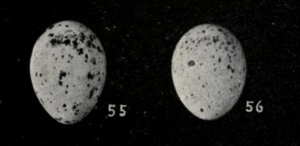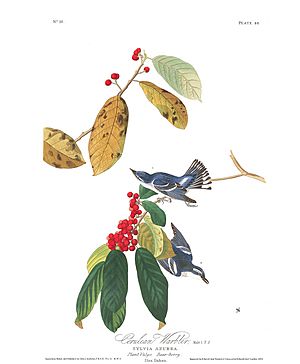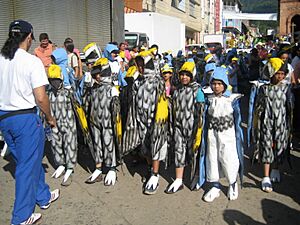Cerulean warbler facts for kids
Quick facts for kids Cerulean warbler |
|
|---|---|
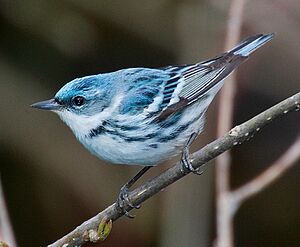 |
|
| Adult male cerulean warbler | |
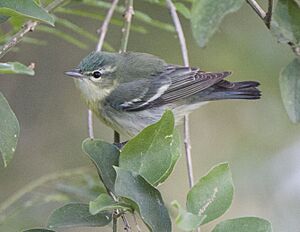 |
|
| Adult female cerulean warbler | |
| Conservation status | |
| Scientific classification | |
| Genus: |
Setophaga
|
| Species: |
cerulea
|
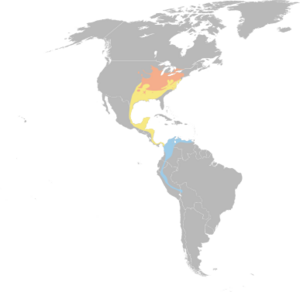 |
|
| Breeding range
Migration range Wintering range |
|
| Synonyms | |
|
Sylvia cerulea Wilson, 1810 |
|
The Cerulean Warbler (Setophaga cerulea) is a small, beautiful songbird. It belongs to the Parulidae family. This bird travels very long distances. It spends its summers in the hardwood forests of eastern North America. Then, it flies all the way to the Andes mountains in South America for winter. It especially likes subtropical forests there.
Male and female Cerulean Warblers look quite different. Adult males have bright cerulean blue and white feathers on their backs. They also have a black "necklace" across their chest. You can see black streaks on their backs and sides. Females and young birds have bluish-green backs. They have a light stripe above their eyes. Their undersides are yellow, and they don't have streaks. All Cerulean Warblers have two white bars on their wings. They also have a thin, pointed beak.
This warbler mainly eats insects. It especially likes insect larvae, but also eats flying insects. It finds its food and builds its nests high up in the forest treetops. Cerulean Warblers are very protective of their space. Males will defend their forest areas. Males usually arrive at their summer breeding grounds a week or two before the females.
The Cerulean Warbler is currently listed as "near threatened." This means it could become vulnerable soon. Its population has been shrinking quickly. However, this decline has slowed down recently. Cutting down forests where they spend winter is still a big problem. This reduces the places they have to live.
Contents
Discovering the Cerulean Warbler
The Cerulean Warbler was first described in 1810. A scientist named Alexander Wilson gave it the name Sylvia cerulea. He first thought the male and female were different species. Later, scientists realized they were the same bird.
For a long time, it was known as Dendroica cerulea. But in 2011, after scientists studied its DNA, it was moved to the genus Setophaga. This is its scientific name today. The name Setophaga comes from Greek words meaning "moth eating." The name cerulea comes from a Latin word meaning "blue" or "azure." This perfectly describes the male bird's color!
The Cerulean Warbler has many relatives in the Setophaga group. These include the Blackburnian warbler and the Chestnut-sided warbler. Sometimes, it even mates with the northern parula. This shows how closely related these birds are.
What Does a Cerulean Warbler Look Like?
The Cerulean Warbler is one of the smallest Setophaga warblers. It is about 11 centimeters (4.3 inches) long. It weighs between 8 and 10 grams (0.28 to 0.35 ounces). Its wingspan is about 20 centimeters (7.9 inches). Males are usually a bit bigger than females. Older males tend to be larger too.
Adult male Cerulean Warblers are a deep, bright blue on their backs. Their undersides are white. They have clear dark streaks on their sides. A "necklace" or band across their chest can be blue or almost black. Older males have brighter colors and wider chest bands. Adult females have yellow undersides. Their backs and heads have a blue-green tint. Females also have a distinct light stripe just above their eye.
Young Cerulean Warblers look similar to adult females. Their backs might be a bit more yellowish. All birds that have learned to fly have two white bars on their wings. They also have white spots on their tail, no matter their age or sex.
The beak and legs of the Cerulean Warbler change color. This depends on the bird's age and sex. Adult males have black beaks. The bottom half is a slightly lighter dark gray. Adult females have dark gray beaks. The lower half might be dark brown. Young birds that just learned to fly have brownish beaks. Adults have black legs and brown eyes. Young birds have dark brown legs and dark brown eyes. Baby birds have pink beaks and legs, and black eyes.
The Cerulean Warbler's Song
Their song sounds like a buzzing, speeding-up zray zray zray zray zeeee. Their main call is a buzzy, metallic zzee. Males sing to attract mates and to mark their territory. Cerulean Warblers can even copy the songs of other birds. Females rarely sing. However, they often make calls when they are nesting. An alarm call warns others if a predator or another bird threatens the nest.
Where Do Cerulean Warblers Live?
The Cerulean Warbler loves large, untouched forests in summer. These are forests with many mature deciduous trees. They build their nests very high up in the treetops. Nests are often more than 30 meters (98 feet) high. Each pair usually claims an area of about 2 hectares (5 acres). They search for food throughout the middle and upper parts of the trees. Generally, a forest area larger than 700 hectares (1,730 acres) is needed to support a group of these warblers. They often choose areas near rivers or streams.
Summer Homes and Winter Getaways
Their summer breeding range stretches from southern Tennessee to southern Ontario in Canada. It goes from the Atlantic Ocean in the east to the Great Plains in the west. Most of these birds breed in the Appalachian Mountains. Smaller numbers live in forests across the United States and Canada. In the past, they were common in southern states like Alabama and Mississippi. But habitat loss has made them move their main breeding areas northward.
The Cerulean Warbler flies over 5,000 kilometers (3,100 miles) between its summer and winter homes. In spring, they fly over land through Central America. They only cross water over the Gulf of Mexico near the Yucatán Peninsula. In autumn, they might fly over the Caribbean Sea. They cross from Florida to Cuba and then to South America. This migration takes 40 to 70 days. Much of this time is spent resting at stopover spots. Birds might stay in one place for 2 to 18 days.
Their winter homes cover a wide area of northern South America. This extends south along the Andes mountains. They have been found as far south as Bolivia. In the north, they are often seen in Colombia and Venezuela. The Cerulean Warbler prefers tall forests. So, you often find them in old subtropical forests. They also like shade coffee farms. These farms grow coffee under taller trees. They live at altitudes of 500 to 2,000 meters (1,640 to 6,560 feet) in their winter range.
A few Cerulean Warblers have been seen far from their usual paths. One was spotted in Iceland. Another was seen in Florianópolis, Brazil. This was over 2,500 kilometers (1,550 miles) outside its normal winter area.
Life of a Cerulean Warbler
What Do Cerulean Warblers Eat?
The Cerulean Warbler searches for food throughout the forest treetops. It mostly feeds in the middle and upper parts. It hops from branch to branch. It picks small, soft insects from leaves and twigs. In winter, it might also pick insects from flowers. It mainly eats butterfly and moth larvae. It also adds flying insects to its diet. In its winter home, it especially likes to find food on Inga trees.
Males tend to look for food a bit higher in the trees than females. This difference is usually about 2 meters (6.6 feet). They often join mixed groups of birds while foraging. They share space with birds like the American redstart and Blackburnian warbler. These other birds look for food at different heights or on different parts of trees. This helps prevent them from competing for food.
Reproduction and Family Life
Cerulean Warblers usually have only one mate at a time. Their summer breeding season is short. This means they usually raise only one group of young each year. During breeding season, males and females are very aggressive towards others of the same sex. Males sing to mark their territory. They might even fight physically, sometimes falling from heights of 20 meters (66 feet). Female Cerulean Warblers have been seen attacking other females and destroying their eggs.
Building a nest takes about 7 days. The female lays 3 to 5 eggs over about 7 days. She sits on the eggs for about 12 days to keep them warm. The baby birds stay in the nest for about 11 days. Only the female sits on the nest. However, the male often brings food for her and the young. Sometimes, young birds in a nest might have a different father than the male who helps raise them. Males often stay close to their mate. They guard her while she looks for food, builds the nest, or chooses a nest spot. The male also often sings a soft "whisper song." The female sometimes calls back.
While the female is sitting on the eggs, or when the young are in the nest, she might also sing. Her song is a more complex version of her usual nest call. It sounds like a metallic zee zeet zee zeet zeet.
Both parents help choose a nest site and build the nest. Nests are usually on horizontal branches high in the forest canopy. They are often shaded by leaves. The Cerulean Warbler likes to nest over an empty space. This means there are no branches for a meter (3.3 feet) or more below the nest. The nest is made from tree bark, grasses, and lichens. These are woven together using caterpillar silk and spider thread. If a nest fails, the birds often reuse materials from it. This is especially true for the strong binding threads. Cerulean Warblers have even been seen building "double-decker" nests. This is when a new nest is built on top of an old one. Most known nests are in deciduous trees. However, some have been found in pine trees in southern Indiana.
After the eggs hatch, the parents feed the baby birds. They mainly give them moth and butterfly larvae. The young birds become independent about 12 days after leaving the nest. About 34% to 62% of young birds survive this stage. Newly fledged birds are sometimes caught by chipmunks. Young birds also look for food in slightly different places than adults. They prefer areas near rivers with fewer leaves.
Who Are Their Predators?
Nesting high in the forest canopy helps protect Cerulean Warbler nests. However, their eggs and young can still be eaten by predators. These include raccoons, squirrels, chipmunks, snakes, and even other birds like blue jays.
Cerulean Warblers can also get blood parasites. These are tiny organisms that live in their blood. Sometimes, other birds like brown-headed cowbirds try to lay their eggs in a warbler's nest. This is called nest parasitism. But it's less common for Cerulean Warblers. This is because they prefer dense, high forest areas where cowbirds don't usually go.
Protecting the Cerulean Warbler
The Cerulean Warbler is currently listed as a near threatened species. This is according to the International Union for Conservation of Nature. It is the fastest declining Neotropical songbird that migrates. One of its biggest threats is the rapid loss of its winter habitat in the northern Andes. Cerulean Warblers need shade coffee farms. These farms have the mature forest habitat they require.
However, traditional shade coffee farming is under pressure. This is due to changing coffee prices. Many shade coffee farms are being changed to sun coffee farms. Sun coffee farms grow coffee in open areas, which means cutting down more trees. This also means converting to other crops.
In forests that are broken up into smaller pieces, the Cerulean Warbler is more likely to have its nest taken over by brown-headed cowbirds. In the past, their preferred tall forest homes protected them. But cutting down forests has made their nests more open to cowbirds.
This bird's numbers are declining faster than any other warbler species in the USA. In 2006, its population was less than one-fifth of what it was 40 years before. The American Bird Conservancy (ABC) is working with its partner in Colombia, Fundación ProAves. They are protecting winter habitats for Cerulean Warblers and other migrating songbirds. In 2008, they created the Cerulean Warbler Bird Reserve. This was the first protected area made just for a neotropical migrant bird. In 2009, ABC and its South American partners created a plan to protect the Cerulean Warbler's wintering grounds.
Cerulean Warblers in Books and Art
The famous artist and bird expert John James Audubon drew the Cerulean Warbler. It is in his book Birds of America (published between 1827 and 1838). His drawing, Plate 48, shows two warblers on a dahoon holly bush. Audubon painted this in 1822. The original painting is now at the New-York Historical Society.
The writer Jonathan Franzen used the Cerulean Warbler in his 2010 novel Freedom.
In San Vicente, Colombia, there is an annual festival. It celebrates migratory birds, including the Cerulean Warbler.
The character "The Man in the Yellow Hat" publishes a book about the Cerulean Warbler. This happens in the episode "The Big Picture" of the TV show Curious George.
See also
 In Spanish: Reinita cerúlea para niños
In Spanish: Reinita cerúlea para niños





